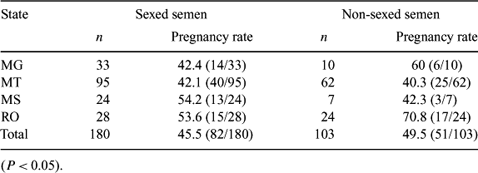305 FIRST REPORT OF THE USE OF SEXED SEMEN BY FLOW CYTOMETRY IN BOS INDICUS
L. Cattaneo A , A. Galassi A , R. Franco A , A. Duarte A , K. Mello A , G. Jáuregui A , J. Lagioia A and M. Basualdo AAGoyaike Brasil Agropecuária Ltd., Uberaba, Brazil. Email: lcattaneo@goyaike.com
Reproduction, Fertility and Development 17(2) 303-303 https://doi.org/10.1071/RDv17n2Ab305
Submitted: 1 August 2004 Accepted: 1 October 2004 Published: 1 January 2005
Abstract
The only method of sexing sperm that works in any practical sense is measuring DNA content of individual sperm by flow cytometry, and sorting them based on that information (Schenk and Seidel 2002 J. Anim. Sci. 80 (Suppl. 1), 188). This is, also, the first reference of the use of sexed semen in Brazil. The objective of this experiment was to compare the fertility of sexed and non-sexed conventional semen in Bos indicus purebreeds. Ejaculates from eight Nelore bulls were collected by artificial vagina, diluted, and stained with Hoeschst 33342 (Schenk et al. 1999 Theriogenology 52, 1375–1391). A high-speed flow cytometer (SX-MOFLO®, DakoCytomation, Inc., Fort Collins, CO, USA) was used for sorting X sperm. Sexed semen was then packaged at 3 million total sperm in 0.25-mL straws and frozen. The average estimated purity obtained by resort analysis of one straw per batch was 91.5%. An aliquot of each ejaculate was frozen unsexed at a concentration of 50 × 106 sperm/mL in 0.5-mL straws (control). A total of 283 Nelore heifers were synchronized with two doses of PGF2α 12 days apart and inseminated in the body of the uterus 12 h after heat detection. Field trials were carried out in four different states in Brazil: Minas Gerais (MG), Mato Grosso (MT), Mato grosso do Sul (MS), Rondônia (RO). Pregnancy diagnosis and fetal sex determination were performed by ultrasound 30 and 60 days post-AI, respectively. Data were analyzed by chi-square and Monte Carlo methods. There was no significant difference (P < 0.05) in pregnancy rate between sexed and non-sexed semen (see Table 1). At the time of abstract submission, of 41 pregnant heifers from sexed semen confirmed by ultrasound, 40 had a female fetus (97%). These results indicate that sexing semen by flow cytometry could be a very important tool to accelerate the genetic gain in Bos indicus cattle. Brazil has the largest commercial herd in the world and, therefore, a great potential to incorporate this technology that is now available in the country.

|


